| Title | Tora! Tora! Tora! |
| Studio | 20th Century Fox |
| Date Released | September 23, 1970 |
| Director | Richard Fleischer (U.S. sequences) |
| Actors | Many and varied |
| Aerial Coordinator | Jack Canary, David Jones, Art Wildern, George Watkins |
| B-17 Filming Locations | Mostly Wheeler AFB, Hawaii |
B-17s Identified
B-17F 42-29782 (N17W)
B-17G 44-83563 (N9563Z)
B-17G 44-85574 (N621L)
B-17G 44-85828 (N3193G)
B-17G 44-85840 (N620L)
The Movie...
Tora! Tora! Tora! was an evenhanded look at the Japanese attack on Pearl Harbor that brought the U.S. firmly into World War II. It presented a detailed account of the planning and execution of the attack from both the Japanese and American perspectives. It is a straight-forward narrative of the attack and as such has suffered criticism for being too much like a documentary. Such criticism was muted, however, with the release of Pearl Harbor in 2003, a dubious "Hollywood" effort that suffers greatly in comparison. The aerial action was filmed on location in Hawaii, using many of the sites of the original attack, though scenes at Hickam AFB were somewhat limited due to the heavy airlift activity underway in support of the Vietnam War.
Jack Canary headed a team that created dozens of Japanese Zeros, Kates, and Vals by drastically rebuilding T-6s and BT-13s, while a pair of P-40s were sufficient to provide the meager Air Corps response. Dozens of full-scale fiberglass P-40s were built, using metal frames, C-45 wings, P-40 landing gears, with several of the mock P-40s also equipped with running Allison engines for taxi scenes. These P-40s served as targets during the attacks. Naval Air was represented by several PBYs and a fiberglass Kingfisher mounted on the replicated USS Arizona destroyed during filming.
The B-17 footage represented a fairly minor part of the story, that of the ill-timed arrival of elements of the 7th and 19th Bomb Groups during the Japanese attack. As part of the effort to reinforce the Philippine Islands, two reconaissance squadrons were in the process of being deployed to Clark Field. Those B-17s that arrived during the raid were planning a fuel stop at Hickam after a long overnight ferry flight from Hamilton Field, California. Twelve B-17s, a mixture of Cs, Ds, and the new Es, actually did arrive pretty much as depicted in the film, short of fuel and unarmed, their defensive guns useless without ammunition (not aboard the airplanes to allow more fuel to be carried). The B-17s scattered across Oahu, trying to avoid attacking Japanese fighters and desperate American aircraft gunners shooting at anything in the air, the B-17s being the biggest targets presented. All of the B-17s landed successfully, but several were subsequently destroyed during strafing attacks.
Hired to provide the B-17s for the filming was Aircraft Specialties of Mesa, Arizona, with its five air tanker B-17F and B-17Gs painted in Air Corps camouflage olive drab and medium grey, turrets bolted to the fuselage and Air Corps (oversized) markings added. Aircraft Specialties also was hired to provide the B-17 crews and aircraft maintenance to the entire Tora air force. The filming was scheduled between December 1968 and May 1969, during the off season of fire fighting, and all five B-17s arrived safely from the mainland in late January or early February 1969. The B-17s appear in ground shots but the interesting scenes show the B-17s in formation over Oahu and then circling over Wheeler AFB as they prepare to land. There are numerous interesting B-17 scenes in the film, one of a dramatic go around from a landing approach, the pilot pulling the B-17 through a tight climbing turn to escape a fighter attack.
No doubt the most exciting B-17 footage was the one-wheel landing, a scene not planned for the film but only occurring after one B-17 crew could not get the right main landing gear to extend for landing. The unplanned "opportunity" was siezed upon, with movie cameras being set up to record the crash landing. A large smoke generator was set up, and the scene is quite dramatic as the B-17 appears through a wall of smoke, the right gear obviously not extended. The Fortress glides to a landing, and then the right wing settles to the runway with the resultant propeller crunches of number 3 and 4 engines as the airplane swings around it right wing tip in a staggering ground loop.
Anecdotal
- Large-scale plywood cutouts of B-17Ds were used in the background to depict larger numbers of early B-17s parked on the Wheeler ramp.
- According to the Internet Movie Database website (linked below), the B-17 pilots were Bill Benedict, George Burnette, Don Clark, Don Fletcher, Bill Groomer, Davie Haines, Allen Mosley, Gary Pylant, Sam Steele, and Jim Stumpf, all presumably Aircraft Specialties B-17 tanker pilots but more information about this is wanted.
Buy this Movie!
Links
Acknowledgements
- Christopher Brame for providing stills from the film.
- Fortress Against the Sun by Gene Eric Salecker
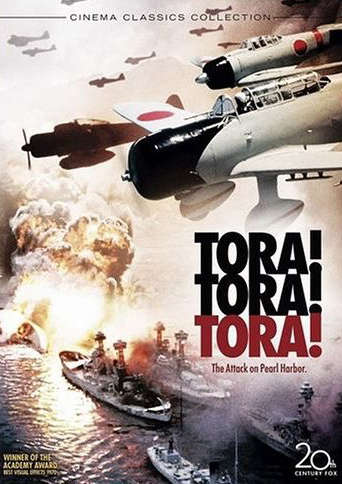
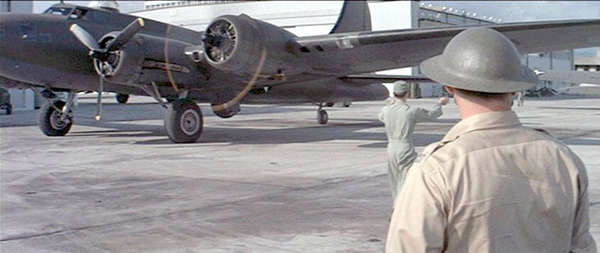
Ground shot of B-17F 42-29782 (N17W) on the ramp. believed to be at Wheeler Field.
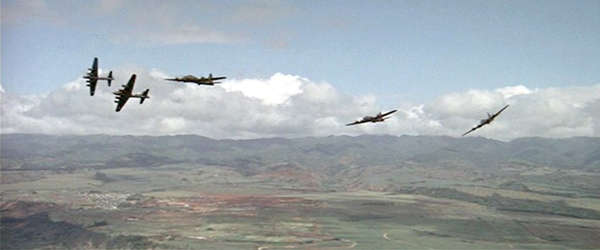
All five B-17s seen together in a scene where the crews break formation to try and find landing fields as they come under attack from Japanese fighters.
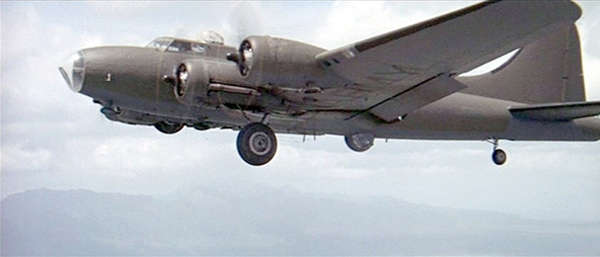
B-17G 44-85774 (N621L) suffered a real emergency when the right main landing gear would not extend. Quick thinking moviemakers set up cameras and a scene for the unfortunate but spectacular landing that appeared in the completed film.
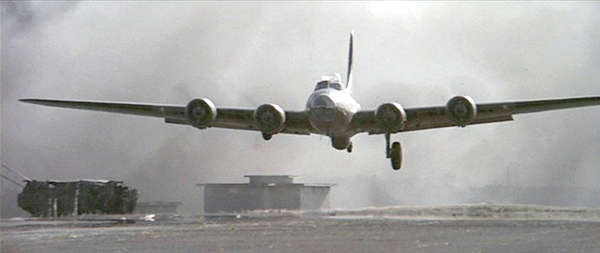
B-17G 44-85774 (N621L) on short final, one down and one up, as seen in this still from the film.
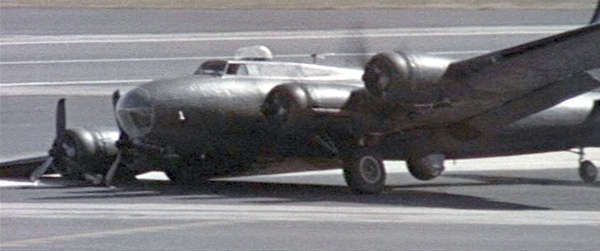
The resulting landing pranged two props and two engines, but not too much else. The airplane was quickly repaired and went back to air tanker duty until it was destroyed in a fatal 1975 crash.